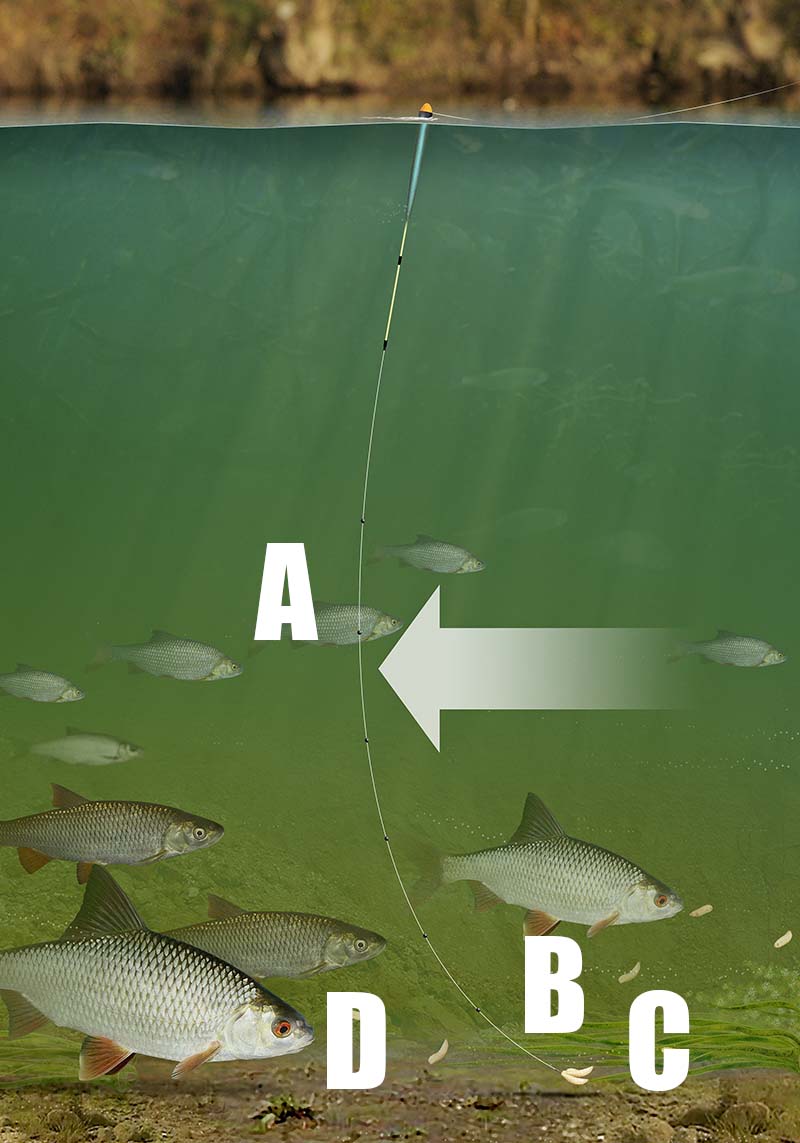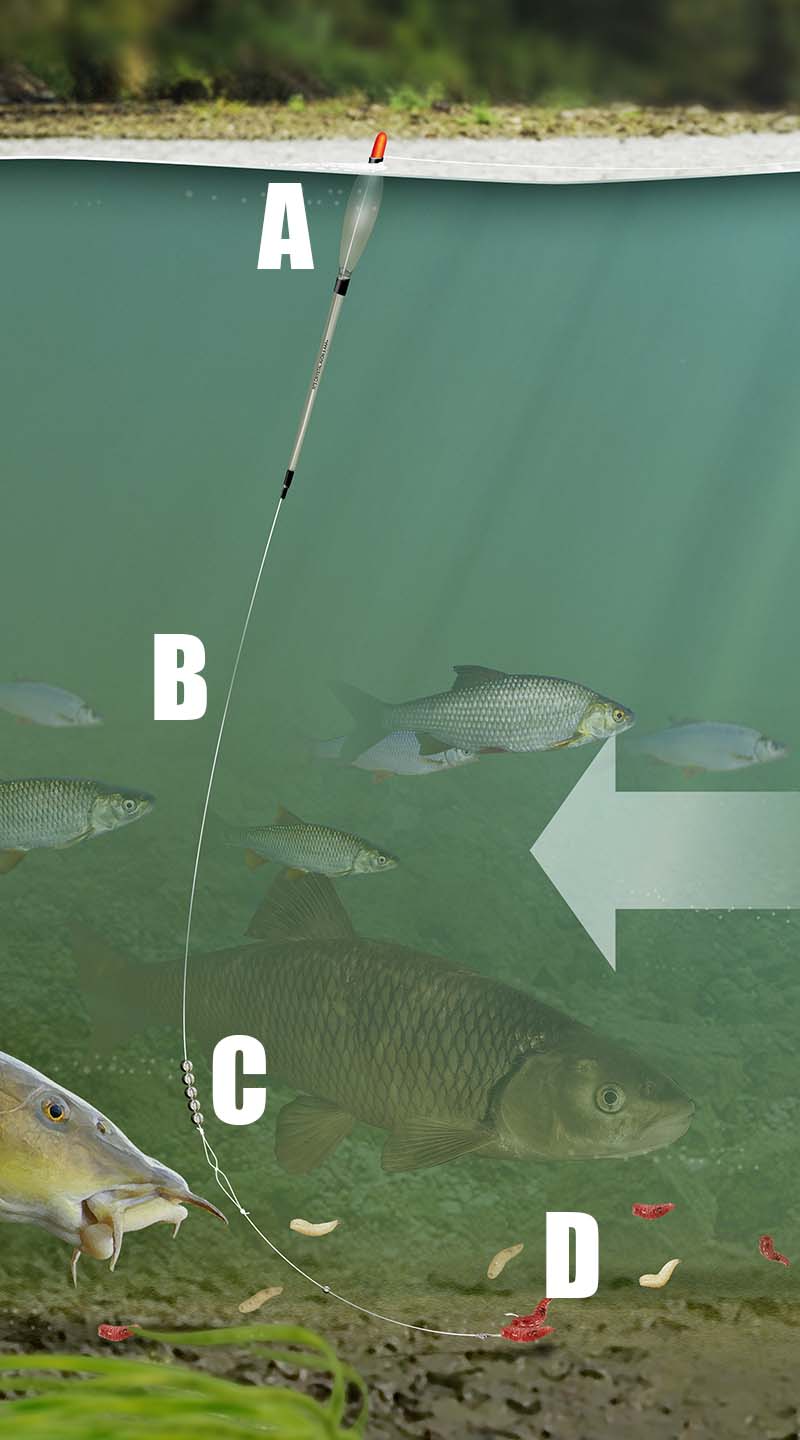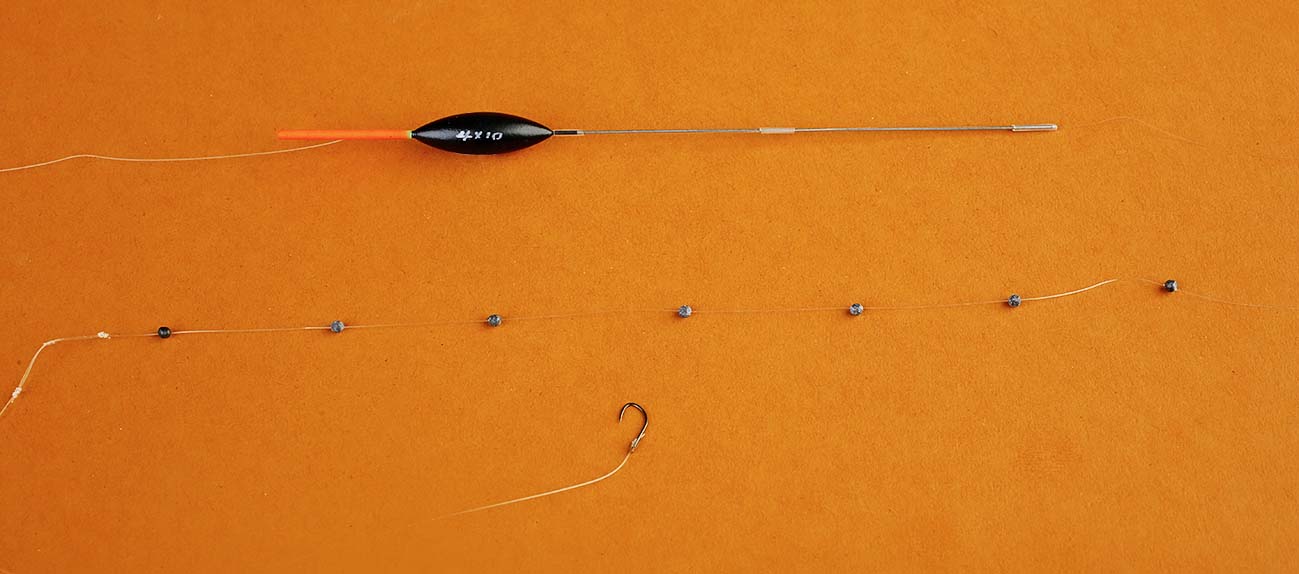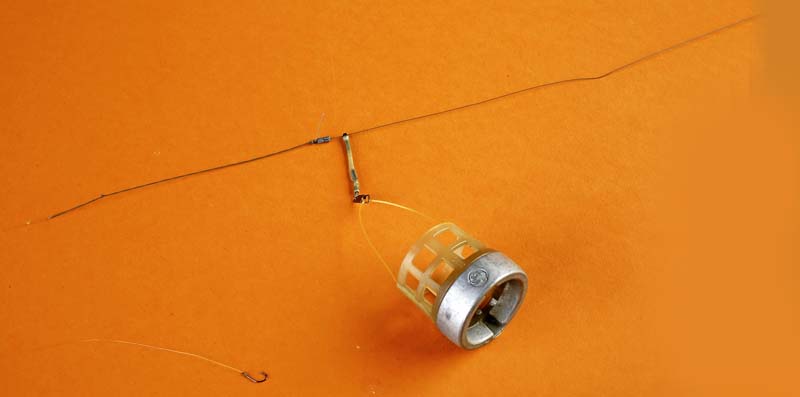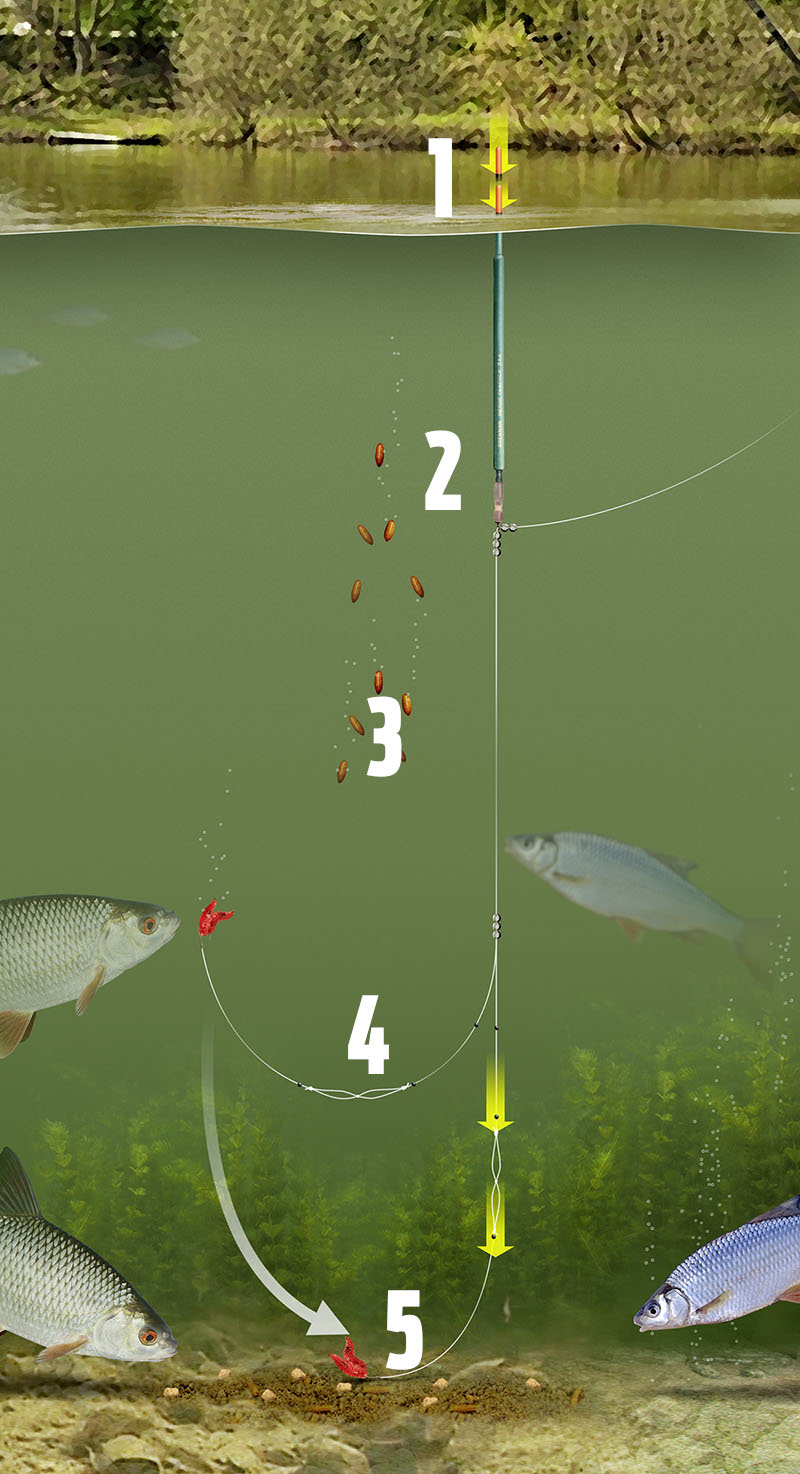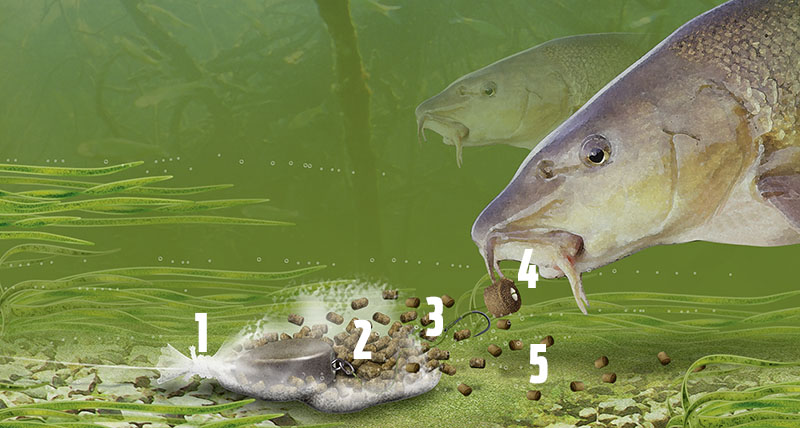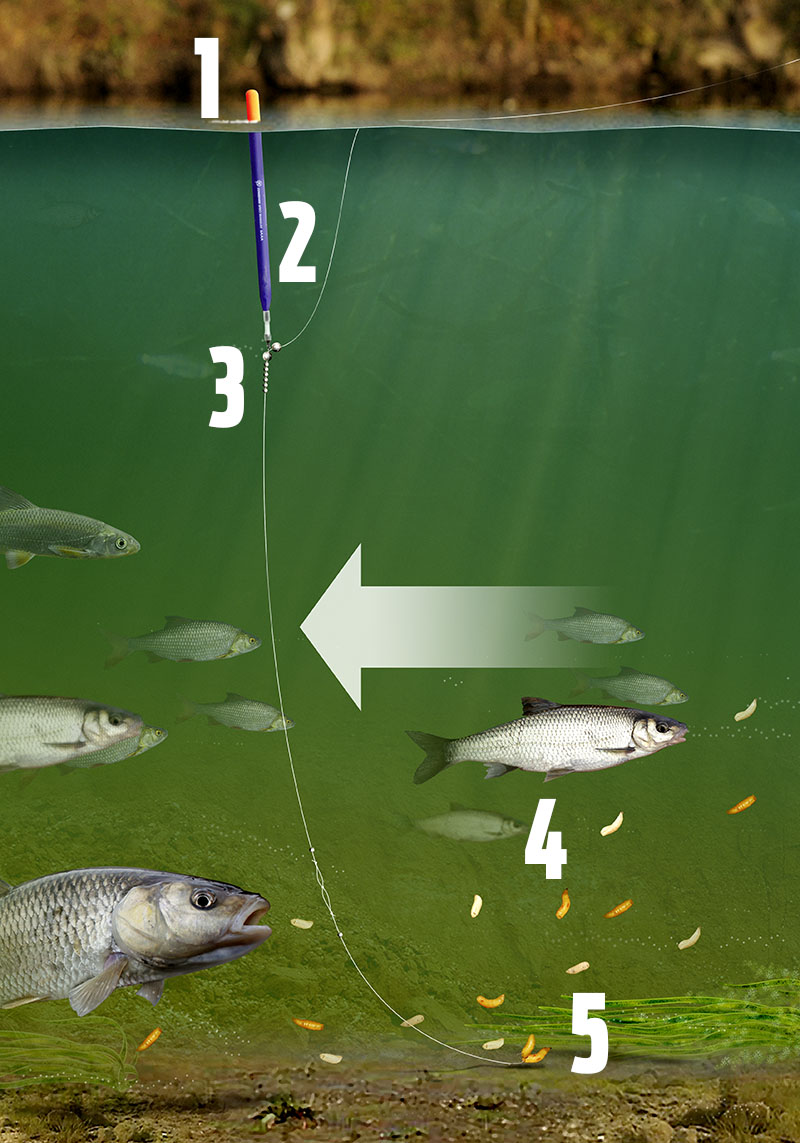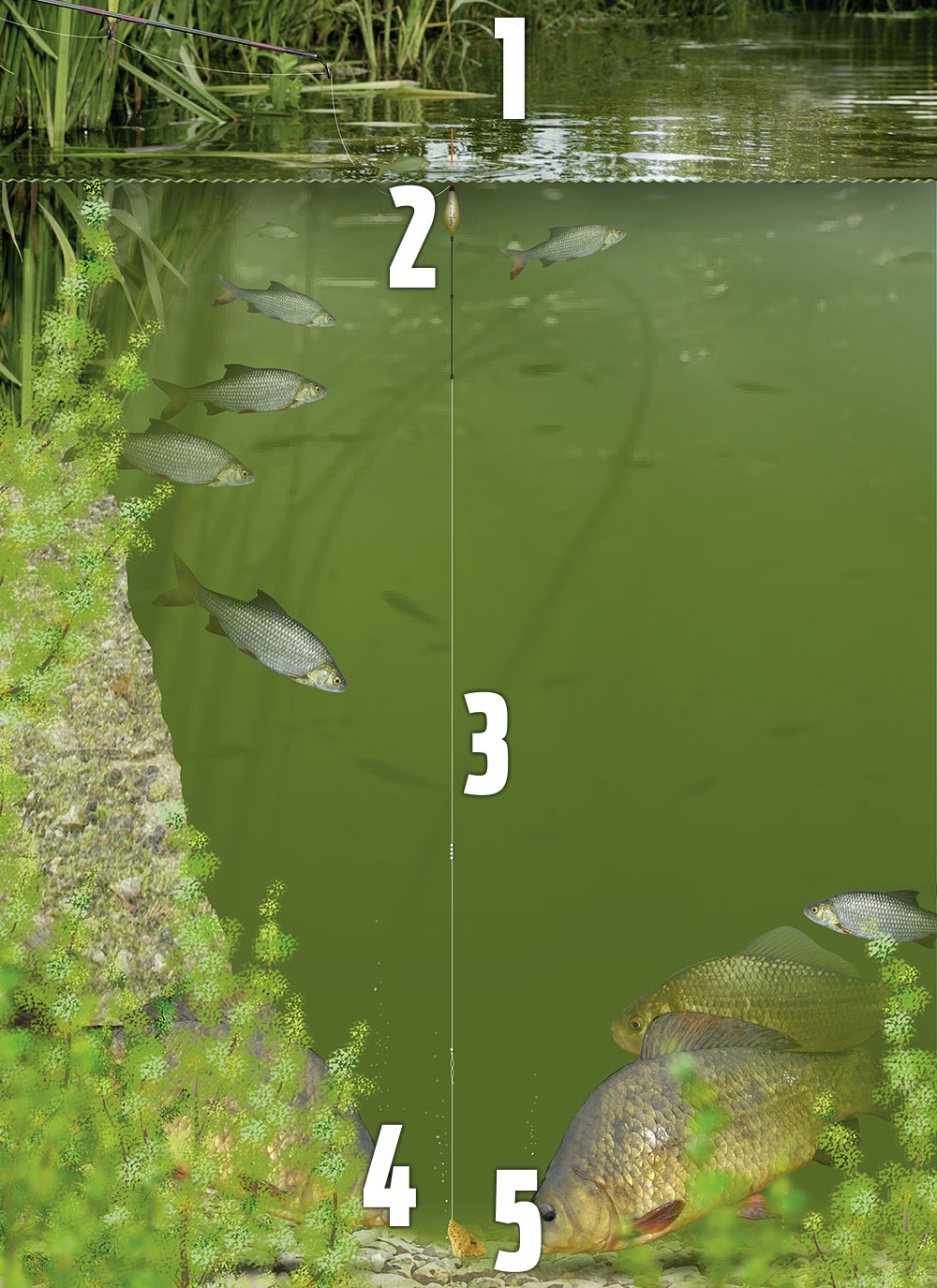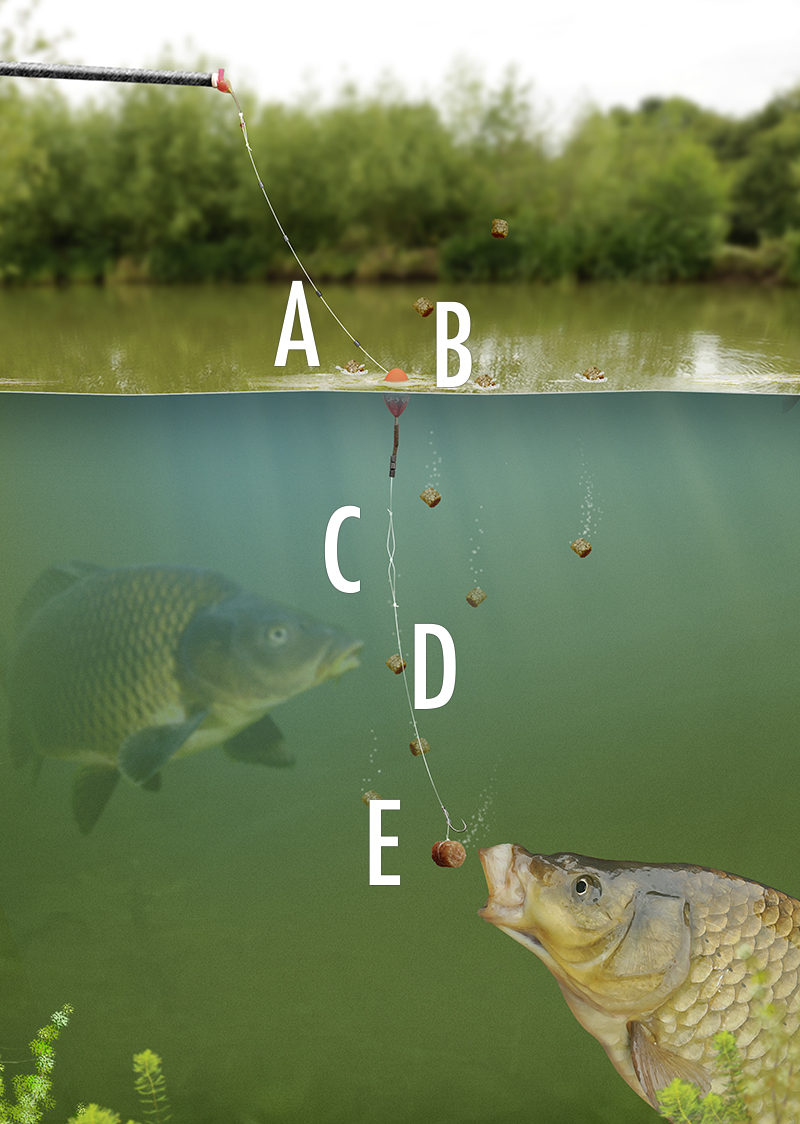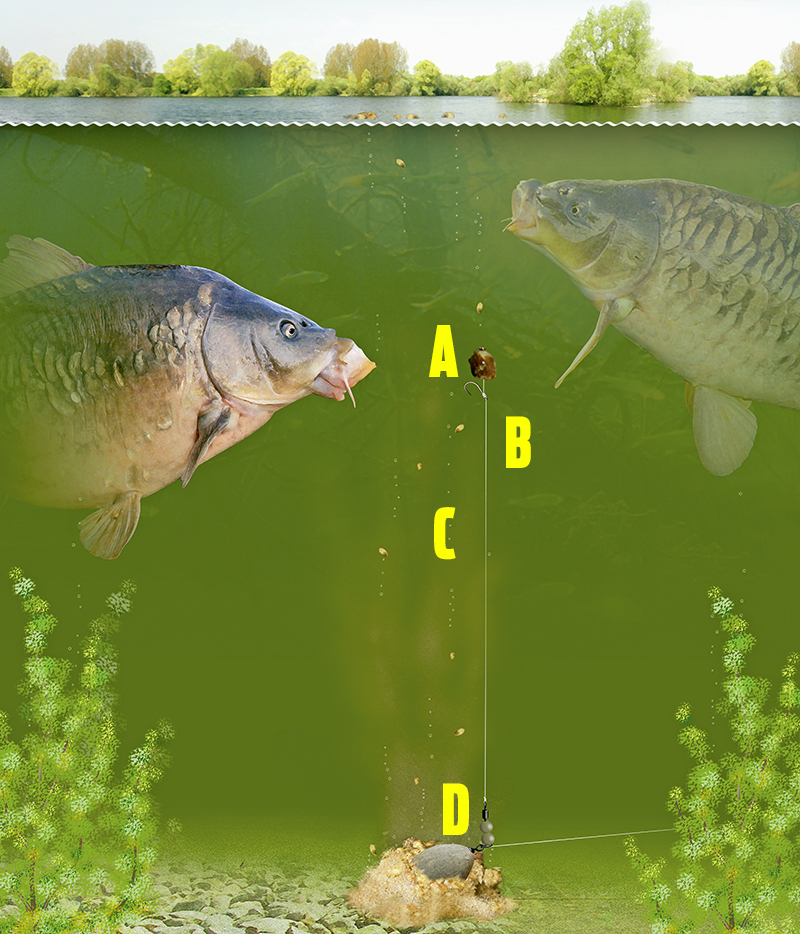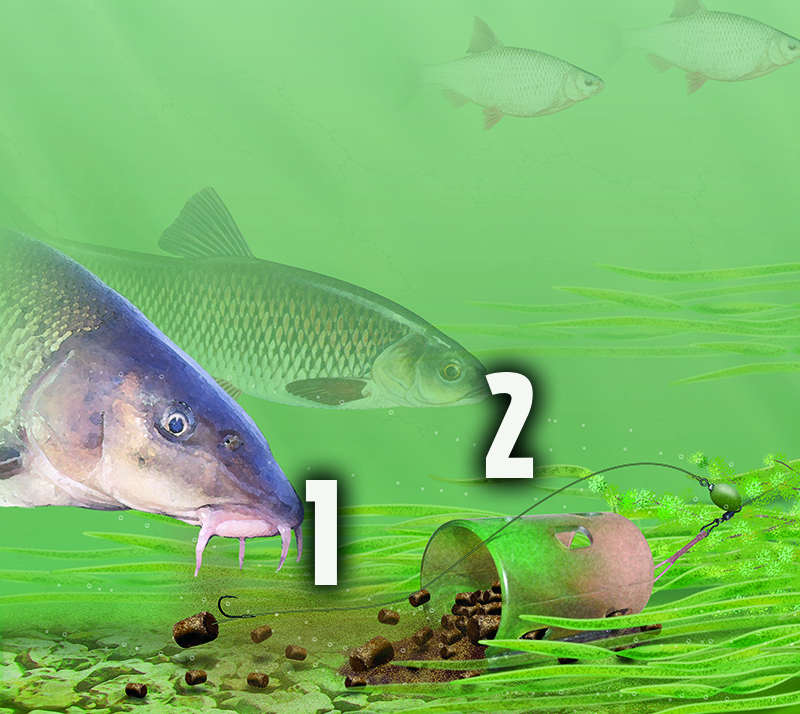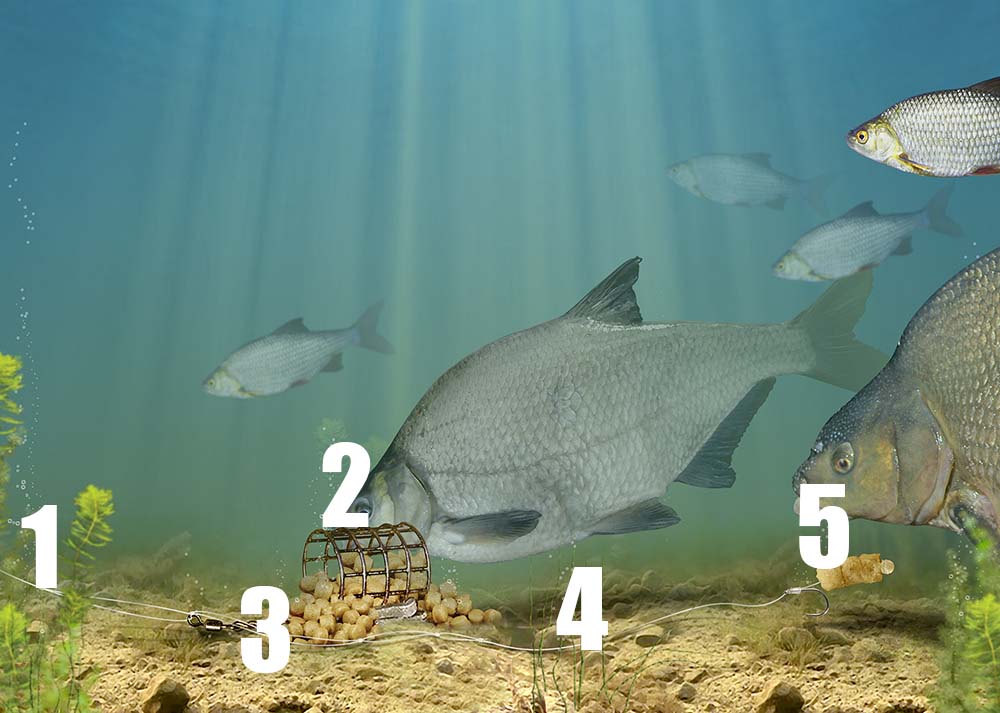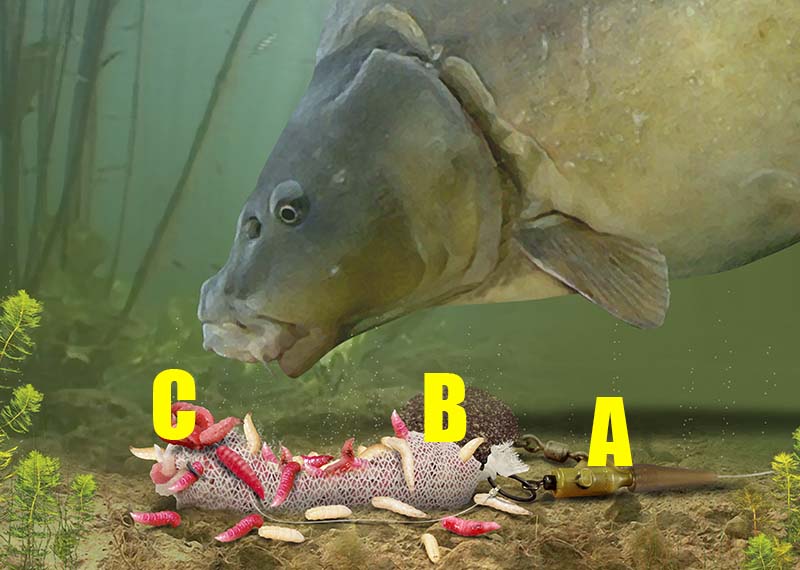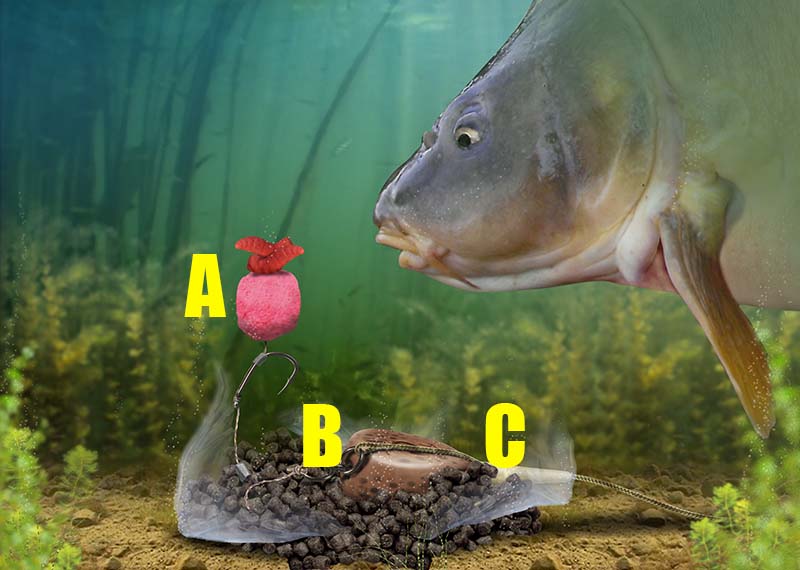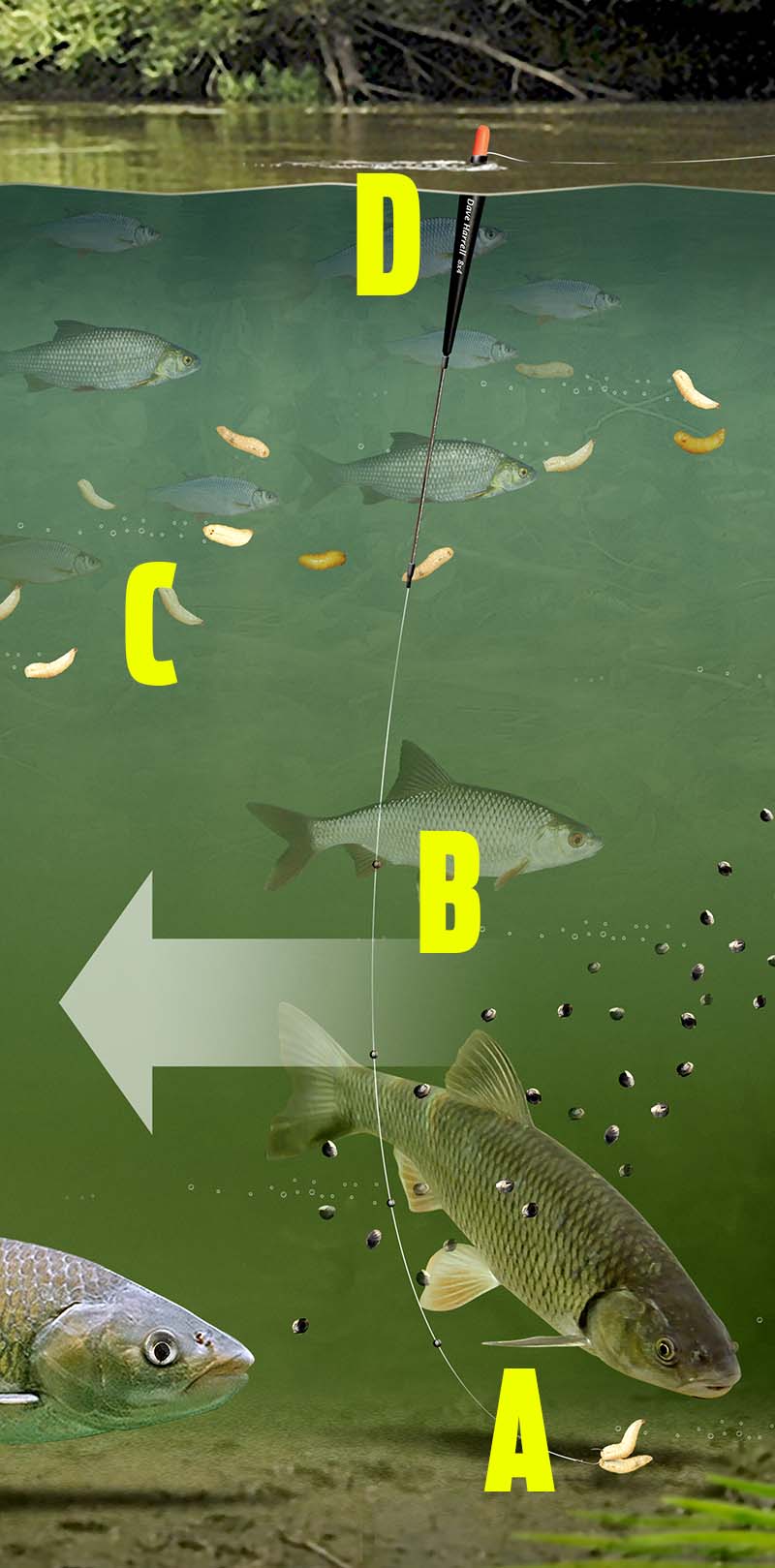Carp fishing rigs | The pellet cone rig for carp
The cold snap has well and truly put the mockers on fishing.
Thoughts of mild weather are a distant memory – but the fish still have to feed and, with a slight change in tactics, it’s still possible to get a few bites from commercial fishery carp.
Whereas the feeder would have ruled in warmer weather, when temperatures tumble and water clears, the pellet cone takes over.
This simple approach is basically bomb fishing but with a cone of compressed micro pellets sat just above the hookbait.
Your bait is placed right in amid the feed and you have the option to feed varying amounts through changing cone size or, indeed, nothing at all by dispensing entirely with the cone.
How to make a pellet cone
• Fill your chosen cone with prepared micro pellets.
• Push a baiting needle through the cone and attach the hooklink.
• Slide the cone down the line until it rests just above the hookbait.
• Ease the cone off and attach the hooklink to your mainline.
How to tie the pellet cone rig.
Bombs
The size of lead you use will be dictated by how far you need to cast, but also the size of the cone. A big cone will be a job to cast 50 yards with a 0.5oz lead. Put simply, if the lead and cone somersault on the cast then the weight is too small. As a guide, a 1oz lead is about right for general commercial fisheries but on big reservoirs, you may want to think about upping this to 2oz.
Hooklink length
Eight inches to a foot is about right, ensuring that the lead is kept away from the cone and hookbait to avoid any chance of spooking fish in clear water. This is also long enough to eliminate the chance of tangles on the cast as the cone wraps around the lead, as can happen with a shorter link.
Which pellets?
Micro pellets are the only size you’ll manage to squeeze into a cone, but they’ll need preparing first. Soaking them in water for a few minutes and then draining them off and leaving them to dry will do the job but give this process time, allowing the water to fully penetrate and completely soften each pellet. For long casts you can add a pellet binding powder to them if you wish, although this may slow down how quickly the cone breaks up in the water.
Pellet cone sizes
Commonly, there are three cone sizes on the market. Just as with feeder fishing, which one you pick will govern how many pellets you feed. The smallest cone is ideal for cold, hard days, while the biggest size is the one to pick for big carp on mild days when the fish may be a little hungrier, or if you plan on leaving the rig out for a long time.
Roach Fishing Rig | Stick float roach rig
Rain means added flow on our rivers and this is when the stick float comes to the fore. It’s capable of running a long way down the swim and searching a lot of water.
The waggler rarely works in these high water conditions, which means a top and bottom-style float is a must.
Highly buoyant and easy to see when trotted a long way down the swim, the stick also offers great control and stability when riding uneven water. It lets you slow the run down to half the pace of the river, or even make the tackle stand stock still.
A) Shotting
Sticks can be shotted with a bulk to keep the bait on the bottom in any strength of flow but in autumn when the fish will still be reasonably active, using a strung-out pattern (known as shirt button style) lets the hookbait behave very naturally in the swim.
Checking the float to a standstill will see the bait rise up off the deck slightly, which can often induce a bite.
B) Depth
You can fish overdepth with the stick float in slower water but to get the best out of the float, set it just touching bottom. This will stop the float from being dragged under in strong currents.
C) Bait
Go big! Double maggot or caster is a meal few roach will be able to resist, or you can take a leaf out of the specimen hunting book and use a piece of breadflake in clear water for a real specimen.
D) Feed
Regular feeding is essential to ensure a steady stream of bait is going down the peg. This will not only keep fish in the swim but also draw any sat well downstream – these will move upriver to investigate the free flow of food. Maggots, casters and hemp are all good choices, fed every cast.
Barbel Fishing Rig | Big top and bottom float rig
Targeting fast and shallow swims flanked by willow trees for big chub and barbel is adrenaline-pumping stuff.
You’ll have a real battle on your hands once a fish is hooked – and the tactic needs a very different top and bottom float set-up to a traditional stick float rig.
Owing to the pace, you need to fish a heavy Avon-style float taking several AAA shot to not only give you great control of the rig but to also get the bait down to the bottom quickly.
Lines and hooks also need to be strong, as your tackle will take a lot of punishment over the course of a five-hour session. It’s not really for the faint-hearted, but the results can be truly satisfying!
A) Float size
With the river running at full pace, your float won’t be in the swim for that long because it will soon trot out of the peg.
To get the bait to the bottom at the head of the swim, pick a big top and bottom float taking 4-5 AAA shot. This will let the float cock immediately and begin fishing because a bite can often come right at the head of the swim.
B) Pile on the pressure
When a fish is hooked, don’t stand back and admire the curve in the rod – the fish will do you in a snag! Instead, wind right down and pull hard on the fish to subdue that first run and put you in charge of the fight.
A through-actioned rod will help here, absorbing the lunges and runs without the danger of a snapped hooklink.
C) Bulk shot
In shallow swims you’ll not get bites on the drop and the aim is to get the bait down to the bottom in seconds.
This means a very simple and positive shotting pattern made up of all the float’s weight grouped into a bulk just above the hooklink. Typically this will be made up of large BB or AAA shot.
D) Proper tackle
Not only are the chub and barbel you’re aiming for of a decent size, but the riverbed may be uneven, with lots of rocks.
Naturally, a hooked fish will do its best to cut you off by rubbing the line against these snags.
It makes sense then, to use heavy tackle with a hooklink of around 0.16mm or 0.18mm and a strong size 14 or 12 hook for fishing big baits.
Five amazing fishing rigs
Here are five amazing fishing rigs to help you catch more next time you are on the bank. Whether you fish with a pole or a rod these rig will keep you catching all day long and give you the best chance of perfectly presenting your bait. So here are five of the best fishing rigs with Steve Ringer.
Carp Ape
The KC Carpa Ape is a versatile float pattern that I use for lots of different options, ranging from shallow work to mud-line fishing against an island.
In autumn it comes into its own for fishing across in 18ins to 3ft of water on a snake lake.
Mainline: 0.15mm Guru N-Gauge
to a 4ins hooklength of 0.14mm Pure Fluorocarbon, which I really like at this time of year when the colour starts to drop out of venues – I’m convinced it gets me those extra bites.
Hook: Size 16 or 18 Guru F1 Pellet. These are perfect for pellets, corn and even maggots.
Shotting: Normally a tightly strung bulk of No10 shot. However, if the water is very clear I will string these out more to achieve a slower fall of the hookbait. Mix it up to find out what works best on the day.
Mick Wilkinson F1 Slim
I designed this float with Mick as I wanted a slim-bodied wire stemmed float with a relatively short bristle that sits quickly when lifting and dropping the rig.
Mainline: 0.13mm Guru N-Gauge to a 4ins hooklength of 0.10mm Pure Fluorocarbon. Fluoro gives me an edge once the water starts to clear.
Hook: Size 18 Guru F1 Pellet for maggot and pellet work. This fine-wire hook is spot on for F1 fishing and is easily s’ ’carp too.
Shotting: This depends on whether I am maggot or pellet fishing. For maggots I’ll always opt for a loosely strung bulk of No11 shot and for pellets a tightly strung bulk. My theory has always been that shy-biting F1s follow maggots down before sucking them in, so a slowly-falling hookbait is important.
This is backed up by the fact that when maggot fishing most bites come just as the float settles.
Pellets seem very different. I always feel a more positive shotting pattern works better.
Carpa Perfect/Gloucester
My favourite pattern for deep-water silver fish work, I use this for all my Irish work as well as winter pellet fishing for skimmers.
This float features a wire stem so is super-stable, plus it has a thick bristle, meaning it’s easily visible in even the poorest of conditions.
Float size depends on depth and conditions. As a guide, for deep-water skimmer fishing in fair conditions I will opt for 1.25g.
Mainline: 0.15mm Guru N-Gauge – quite heavy, but this helps to minimise tangles when shipping in and out at speed. Hooklength is 6ins of 0.12mm Pure Fluorocarbon. There is always the chance of a rogue carp, and this gives me a good chance of landing it.
Hook: Size 16 Guru F1 Pellet.
Shotting: Slightly different to the norm. In deep water I like to fish with positive droppers, so I use double No9s with the first pair 7ins from the hook and the next two 7ins above this. Then, a further 7ins-8ins further up, I have my olivette and shot.
Something I do on all my heavy rigs is fix a few small half-styls a few inches above my olivette. These allow me to fine tune the bristle of the float during the session.
Mick Wilkinson steady
If I had to pick one float to do the lot on commercials, then this would be it! There isn’t a single bait that I wouldn’t fish with it. Pellets, corn, meat and even maggots, the Steady is perfect for them all. It’s also a float I will use on both short and long pole where carp are concerned.
I’m a firm believer that light floats produce more bites once the water starts to clear. I’ll often use a 4x10 float in depths of 4ft-6ft, to give that all-important slow- falling hookbait that appears as natural as possible.
Mainline: For carp it’s 0.17mm Guru N-Gauge to a 6ins hooklength of 0.15mm in the same material.
Hook: Size 16 super LWG which
covers me for both meat and corn hookbaits, as well as maggots and pellets.
Shotting: Loosely strung bulk of No10s, with the bottom shot 6ins from the hook and the rest of the droppers spaced at 1.5ins-2ins intervals above this.
The idea is to get a slow and even fall of the hookbait – when carp fishing in the colder months most bites tend to come just as the float settles, indicating that the carp has spotted the hookbait and followed it down.
Running Feeder Rig
One question I get asked more than any other is how to tie my running feeder rig, which I now feel I have pretty much spot on in terms of knowing I’m always fishing tangle-free.
This is the rig I use for everything from the World Feeder Championships to Ireland. It can be used with or without a shockleader, and whether I use one or not really depends on the distance at which I am fishing.
1: Thread a link on to the line. The one in the picture is a prototype Guru link which is based on my own version. You’ll notice it’s covered in shrink tube, which eliminates any tangle-causing sharp edges or tags. I prefer a short link of 1.5ins.
2: Fix two No8 Stotz on the line.
3: Tie a 3ins twizzled loop below the Stotz.
4: Slide the Stotz down to the knot at the top of the 3ins twisted loop.
5: Tie a 1ins loop in the end of the 3ins twisted loop.
6: Attach your hooklength to this loop, loop-to-loop style.
Roach Fishing Rig | River waggler rig
Few tactics are more fun than running a waggler down a steady stretch of your local river and putting together a mixed bag of chub, roach and other silver fish.
When the conditions are right this is a very successful style of angling, with fish often being caught on the drop as well as when the hookbait is tripping along the riverbed.
Many anglers struggle with this tactic, for two simple reasons. First, they attempt to fish like this when the wind is blowing downstream. This will make presentation very difficult, as the wind will constantly pull the float off line. The type of waggler and its shotting pattern have to be correct, too, to avoid tangles and to present a slow-sinking bait.
Use a waggler with a thick, buoyant tip that resists being dragged off line or under when the hookbait catches the bottom.
Spread the shot evenly to ensure a constant sinking rate and to avoid tangles.
If you follow these simple steps your set-up will work effectively, giving you some fantastic sport.
1) Float adaptor
A float adapter enables the float to be changed quickly and offers little resistance on the strike.
2) Even speed of fall
No6 shot set at 2ft intervals down the line help the hookbait to fall through the water at a natural speed.
3) Maggot hookbait
Big chub and smaller silver fish will both readily take a double red maggot hookbait on a size 18 hook
How to tie a river waggler rig
1) A float adaptor like this enables you to change the size of the float and helps the float fold flat, creating less resistance on the strike.
2) Set the float at the rough depth of the swim and lock it with AAA shot. If the float is rated to 4AAA+ use four AAAs around it.
3) Tie a size 18 hook to an 18ins length of 2.5lb line. This is strong enough to tame any larger chub, yet fine enough to bring plenty of bites.
4) Attach the hooklength to the mainline using a loop-to-loop knot. This ensures the hooklength can be easily changed.
5) Place a No8 shot about 6ins above the hook. This will accentuate bites, and should be set so that it is just touching the river bed.
6) Fix No6 shot at 2ft intervals above the tell-tale shot. These straighten the line on the cast so the hookbait sinks at a natural speed.
Rudd fishing rig | Bread on the float
If there’s one fish species that sums up summer fishing then a big, golden rudd must be it! These stunning fish, with their surface feeding habits, are the epitome of warm-weather angling.
Rudd are famous for taking baits in the upper layers of the water, and they’re adept at picking off small insects which fall into the water from surrounding vegetation.
This makes fishing for them with baits such as casters and slow-falling maggots a great tactic, especially on the float.
However, rudd will take a
big bait too and one of the best is breadflake – a bright bait they can’t fail to miss – and one which is soft and easily sucked in by these rather greedy fish.
Watching big rudd taking floating breadcrust or flake on a sunny day is one of the great sights of summer.
1) Hookbaits
Floating crust or flake is a great starting bait, as it matches your loosefeed, but the fish can become cagey later in the session after you’ve caught a few.
This is when it can pay to use breadflake. Be sure to give the flake a bit of a squeeze so it falls slowly through the upper layers of the water.
2) How far out?
You usually need to fish only a couple of rodlengths out for rudd if you’ve got them feeding properly, but make sure you’ve got enough weight in the float to follow the fish if they spook and move further out.
3) Mainline and hooks
Most anglers will fish ‘straight through’ when rudd fishing to aid presentation of the hookbait, as a knot can easily be seen by the fish in clear water.
Depending on the size of fish, pick a floatfishing line of around 3lb-4lb.
Eyed hooks are usually favoured by specimen rudd anglers, as the extra bit of metal helps when moulding a piece of bread around the hook. Size depends on the size of fish and hookbait but most anglers use between a 10 and 14 for specimen fish.
4) Length of the rig
A 3ft distance between float and bait is a good starting point to help prevent rudd being spooked by the waggler, but be prepared to extend this if the fish do show signs of spooking.
It’s not unheard of to end up using several feet of line in very clear water.
5) Loaded floats
Stealth is the key when fishing for rudd up in the water so a small pellet waggler (normally used for catching carp shallow) or a loaded, clear plastic waggler is perfect for the job. You’re looking for a float that doesn’t dive too deep on the cast, as this will spook the fish.
It’s important to use a loaded float so you don’t need to place shot down the line, as this will constantly drag the hookbait down or back towards the float. Instead of having shot around the base of the float, fix the waggler in place with three float stops – one above the float and two below. This allows you to easily alter the distance between float and hookbait.
Tench Fishing rigs | Maggot feeder rig
Tench love maggots, and a maggot feeder rig gives you the best of both worlds – a pile of maggots presented right on top of your hookbait and an inline feeder set-up to help hook a fish once it has sucked in the bait.
Maggot feeders have accounted for some of the biggest tench caught in the UK, but they also perform brilliantly when you’re after numbers of smaller fish. Repeated casting allows you to build up a bed of bait in the swim.
You’ll need a fair few pints of bait, though, and a gallon fed over a 24-hour session is far from being unheard of!
1) Inline is best
Using a fixed feeder is a no-no on waters with a lot of weed and snags that can tether a fish. Inline maggot feeders, that take a swivel pushed into their end, will stop the feeder and also give you something to attach the hooklength to.
2) Short hooklink
You must have the hookbait near your feed. That means fishing with a short mono hooklength of 4ins hanging directly off the feeder. A shorter link also increases the chance of a hook-up when a tench takes the bait.
3) Fake maggot trick
To help with hooking tench, slip a fake rubber maggot on to the hook shank and over the eye.
This helps to act as a line-aligner and flip the hookbait over when the bait is sucked in by a fish. Alongside this, use three live maggots to impart a bit of extra movement to the hookbait.
4) Go big for baits
You’re going to be using large hooks with this rig (sizes 12 to 14), so pick a hookbait to match. Three or four red or white maggots are perfect.
5) Find a firm lakebed
A maggot feeder rig works best on firm lakebeds that have gravel or hard patches of silt with a minimum of weed.
Roach fishing rig | The waggler
The waggler is the approach that most anglers began their fishing career using.
On a mixed commercial fishery where bites are the name of the game, it’s ideal for a relaxing day catching quality roach with the odd bonus surprise thrown in.
Roach are a species that will feed at all depths, and because of the waggler’s versatility compared to that of the feeder, you can target fish feeding from a foot deep to hard on the bottom, making changes throughout the day to keep in touch with the fish.
Rod and line tactics mean that if you hook a carp or two, you’ve or every chance of getting them out – something that can’t be said for a pole armed with a light rig!
1) Insert or straight?
Insert and straight wagglers perform very different jobs. For all-round fishing the insert can be fished with the bait falling through the water (known as on the drop) or hard on the bottom.
It can also be used for fishing shallow, and can be identified by the thin insert tip. The straight waggler is better for fishing on the bottom, often with a few inches of line laid on the lakebed to present a still bait. The straight waggler has a thick, blunted tip.
2) Float size
If you need a decent cast to find the fish a 3AAA float is about right. If you plan on catching fish close in on the drop a big float isn’t needed. Prepared anglers will carry a range of float sizes, to cover all eventualities, but a 2AAA straight or insert waggler will deal with most jobs.
3) Feeding
What you feed should be based on where you want to catch the fish in the swim. That means using maggots, hemp and casters for fishing off bottom or on the drop, changing to a groundbait attack for catching on the bottom.
A steady trickle of loosefed maggots or casters (a dozen fed every few minutes) will work for catching off bottom.
If you go down the groundbait route, two or three balls with casters and hemp added will get the swim going. You can then loosefeed over the top or rely on a top-up of the odd ball of groundbait when bites fade away.
4) Space the shot
The waggler should be fixed with large AAA or BB locking shot but closer to the hook should be No8 or No10 shot, enough to sink the tip right down. You should end up with five or six shot down the line.
Push these together as a large bulk just above the hooklength for fishing on the bottom or space them between hook and float to give the bait a slow natural fall through the swim.
5) Hookbaits
Classic roach baits are red maggots, casters or small pieces of worm fished as singles or doubles, but a bold big bait can sometimes score.
That means a grain of sweetcorn or even a piece of breadflake are both worth slipping on to the hook now and again.
Barbel fishing rigs | PVA bag rig for rivers
Landing a bait in weed without getting caught up is no problem with the ultimate rig – a solid PVA bag with pellets and the rig inside.
It will sink through weed with ease. Load the bag with a mixture of halibut pellets sizes, and use a short hooklength so the bait will finish up close to the feed.
1) PVA
Solid PVA is a must here as you’ll be putting the hook inside the bag, which can snag on mesh. Choose a fast breakdown PVA so you’re fishing and ready for a bite in the minimum amount of time. Be sure that the bag is big enough to fit the lead, hooklink and a reasonable amount of feed inside.
2) All inside the bag
Add pellets first, then the lead, hooklink and bait. Add more pellets, then tie it off around the top of the lead. The lead must be dry before it goes in or moisture may start the breakdown process!
3) Short hooklink
Because the PVA bag will deposit the feed in a tight spot, you want your hookbait to be close by – so that makes a long hooklength unnecessary. A short 3ins-4ins link running from the bottom of the lead will keep the bait right in amid the feed.
4) Hookbait
Small baits score best on clear summer rivers, and a 10mm or 12mm pellet will get more takes.
5) Pellet sizes
Barbel love rummaging around amid gravel and stones and a mix of different-sized pellets ensures that your feed closely mimics the riverbed. Go for 4mm and 2mm or micro halibut pellets with a few bigger 6mm baits added. You can even crush some pellets into a coarse powder to add to the bag.
Barbel fishing rigs | Pellet feeder for chub and barbel
One tactic is synonymous with catching barbel on rivers – the blockend feeder. Allowing you to put a stream of bait into the tightest of spots that can’t be accessed with a waggler, the blockend has caught thousands of barbel down the years. Maggots are most often associated with the tactic, but in recent years pellets have come increasingly to the fore.
Barbel seem to love the taste and smell of halibut pellets, especially in coloured water, and unlike maggots, they won’t pull in dace and bleak that can prove to be a real pain to the angler in search of a few big barbel.
Use pellets and you know that when the bite alarm goes off or the rod top heaves over, it’ll be a barbel!
1) Always use a running rig
The chances of a barbel finding a snag are high, even if the angler concerned is highly skilled, so if disaster does strike and the line breaks, you don’t want the fish to be towing a heavy feeder around.
By having the feeder running on the mainline, stopped by a bead with a tail rubber to cut down on tangles, you can fish safe in the knowledge that no harm will come to a lost fish.
2) Feeder weight
This is decided by the power of the flow and how far you need to cast. Obviously, the feeder must be heavy enough to reach its destination but once it’s settled, it should only just hold bottom.
A fish that takes the bait will easily dislodge the feeder, causing a big ‘drop back’ bite on the quivertip. Too heavy and the feeder won’t move – the fish will feel the disturbance and drop the bait.
To get the right balance, pick a feeder that’s slightly lighter than needed and then add some extra lead. This can be in the form of specially-made stick-on weights or a length of lead strip, available from DIY shops. Add one small piece at a time until the feeder just holds bottom.
3) Length of hooklink
When it comes to the hooklength, as in any type of feeder fishing, this can vary from a short 12ins tail to a long flowing trace of up to 4ft. Start with around 2ft, but if positive bites are coming quickly and no fish are hooked, shorten this by three or four inches at a time.
Likewise, if you get knocks but nothing develops, lengthen the hooklength until you get hook-ups.
4) Serious tackle
You can’t leave anything to chance with tackle, as barbel are powerful fish that will be found in the main flow of the river.
A robust 8lb or 10lb mainline to a hooklink of 8lb is a minimum, matched to a large forged hook in sizes 16 to 12. An eyed hook will also allow you to fish with a pellet in a band, or drilled and hair-rigged.
5) Go for halibuts
Where pellets are concerned, it’s tough to beat halibuts. Their oily make-up offers more attraction in coloured water than a plain carp-style pellet. Big is best, so starting on an 8mm bait and working up to a 12mm is a sensible move. Inside the feeder, cram a mix of pellet sizes such as micros, 4mm and a few 6mm offerings.
Chub fishing rigs | River waggler rig
Chub are bold feeders, and will often sit in among smaller fish like dace, bleak and gudgeon.
For anglers, this means that one rig can be used to catch a real mix of species, and the waggler is by far and away the top attack for running water.
Versatility is the key trait of the waggler, allowing you to change from fishing a few feet deep one minute (if the fish show signs of coming off bottom), to dragging a bait along the riverbed, through to casting just inches away from far-bank tree cover.
1) Leave some tip showing
Because you will be running the float well down the peg, you need to be able to see it at range, and although the thick waggler has a highly-visible tip, don’t add too much shot to dot it down.
Ideally, leave most of the orange tip on show because bites will be very positive when fishing a bait at the full pace of the river.
2) Pick the right float
Should the swim be less than 4ft deep, a short very buoyant float known as a Specimen Waggler will be needed. It looks more like a pellet float designed for carp fishing on commercials. This float will not be dragged under easily and can ride uneven currents with ease.
For a standard deeper swim, look at a straight peacock waggler of 3AAA to 4SSG, depending on the distance needed to cast.
If you plan on fishing off bottom, think about an insert waggler with a thinner tip taking two or three AAA shot.
3) Shot down the line
In a shallow swims you’ll not need lots of weight down the line to get the bait to the bottom.
Two or three No8 shot evenly spread will do the job. If the peg is deeper, these can be pushed together to make a small bulk if needed, especially if bleak are grabbing the bait on the way down.
4) Regular loosefeed
Chub and dace will only be tempted into having a go if bait is constantly being introduced into the swim.
That means loosefeeding by hand or with a catapult, putting in a dozen or so maggots or grains of hemp with a few casters mixed in. Don’t break the feeding cycle and discipline yourself to keep the bait going in.
5) Fish at dead depth
If you set the float overdepth you’ll be in for a session of striking every time it is dragged under by the riverbed.
Spend a fair bit of time running the rig down the swim and making minute adjustments until the hookbait is just trundling along the bottom. To catch gudgeon or ruffe you will need to drag the bait overdepth, though!
Carp fishing rigs | Method feeder
There are a number of different types of rigs that you can use on commercials for carp fishing, and new versions and ideas are appearing all the time, but which one is really the best?
By far and away the most sensible choice is the Method feeder. It allows you to tuck a bait inside a ball of feed and have both mixed together once the feed breaks down in the water.
It’s also a self-hooking rig, meaning there’s no hitting tiny knocks on the quivertip. When a fish is on, you’ll know about it as the rod goes round!
Making the rig is easy, too. Most fisheries insist on your set-up being free-running, but modern tackle means that even elasticated feeders can be used safely.
Guru has its X-Safe system that allows the feeder to pull free of the line in the event of a breakage or the rig becoming snagged.
Elastic acts as a shock-absorber when playing a big carp under the rod-tip, which greatly reduces the number of last-minute hook pulls.
1) Lines and hooks
Big carp can give savage bites on the Method, so don’t skimp on lines. A tough mainline of around 8lb is the order of the day, matched to a 4ins hooklink of low diameter line in a similar breaking strain.
The short hooklink means that the bait will always be close to or in amid the feed. For hooks,
a barbless eyed carp pattern in sizes 16 or 14 will do. The eye is important, as it will allow you to hair-rig baits.
2) Top hookbaits
When a Method load breaks down, you want your hookbait to pop out and be easily visible to the fish, so give them something bright.
A hi-viz orange or yellow mini boilie or wafter, or a brightly-coloured 6mm pellet are good options but often, a plain hard pellet can bring equally good results. Don’t forget dead red maggots or a piece of corn either.
3) What to put around the feeder
Your feed is moulded around the frame of a Method feeder using a special mould, and there are only two choices of feed here – micro pellets or groundbait.
For out-and-out carp fishing, pellets work well. These need to be dampened slightly to help them stick around the feeder. Fishmeal groundbait comes into play when the carp are of a smaller stamp, and normally this is mixed 50/50 with micro pellets.
4) Feeder size
Method feeders range in size from tiny 15g models to massive versions taking over 50g. The size you pick is dependent on how far you need to cast, and any underwater countours.
For long casts, obviously a big feeder will do the job but for short chucks, a much smaller model will do.
Heavy feeders also come into play if you are fishing on an slope running away from an island, the extra weight helps the feeder to grip the lakebed as opposed to sliding down this slope.
5) Safe elastication
If you go down the elasticated feeder route, pick the Guru X-Safe system. This sees heavy pole elastic inside the feeder body stretch when a fish is being played, helping subdue the carp in double-quick time.
Should a fish get snagged and the mainline break, the feeder can pull free to prevent the carp being tethered.
Crucian fishing rigs | paste on the pole
Crucians are famed for their delicate feeding, and smaller fish can give hundreds of missed bites before you connect with them. However, big specimens are quite bold and a scaled-down carp approach picks them off well.
It’s all about presentation and placement of the bait. Much crucian fishing takes place at close range just a few metres off the bank, which makes the pole a sensible option for the angler.
Not only can you drop the hookbait in just the right place but you can keep the rig still and hit lighting-fast bites in a split second – far quicker than if you were using rod and line tactics.
1) Where to fish
Because crucians feed at close range, you need to spend a bit of time plumbing about the peg to find the ideal spot.
This will be just at the bottom of the marginal slope or shelf on a flat bottom free of weed or snags, but it can also be worth feeding a swim on top of this shelf close to features such as reeds or lily pads, provided there is a minimum of a couple of feet of water to play with.
2) Dot the float down
Rarely will a crucian pull the full bristle of a float under and often the only sign you’ll get is a sinking of a centimetre or so.
To counter this, shot the float to leave a tiny speck of float bristle showing. Any touch on the bait will immediately sink the tip.
3) Fish at dead depth
Presenting a hookbait overdepth will lead to missed bites. Crucians often give no indication at all on the float. Get an accurate depth reading and fish with the bait just touching bottom and you’ll give yourself a much better chance of seeing a bite and hooking the fish.
4) Scale down tackle
Crucians on the whole are not big fish, so strong arm tackle isn’t needed.
A rig resembling something you might use for roach will be fine, and that means a 3lb mainline, a hooklink of the same breaking strain but in modern low diameter line and a small lightweight hook. Look at size 18 or 16 hooks and a rg finished off with a slim pole float taking around half a gram.
Pick a float with a very thin bristle. This will show up every indication better than a thicker-topped float.
5) Go for paste
Maggots or casters may attract nuisance fish. Expander pellets are a good hookbait but big crucians just love a nugget of soft paste wrapped around the hook. The softer the paste the better, as the hook will pull through easily on the strike. Make your paste from a fishmeal groundbait, aiming to achieve a consistency similar to that of putty.
Shallow slapping rig for commercial carp
A) Back shots
Fix a few small No10 shot or Stotz between float and pole tip. This will help control the rig and also force you to keep your line tight meaning you’ll hit more bites.
B) Small float
A squat-bodied float will create the maximum amount of noise when it hits the surface, and by having a couple of small shot underneath to cock it, you can create a definite ‘plop’ as you slap. Pick a float taking around 4x8 or 4x10 shot.
C) The right depth
Slapping is designed to catch very shallow, so there’s no point fishing at 2ft deep. Begin at around 6ins deep – but F1s will constantly move up and down in the water so, if bites tail off, add a couple of inches to the depth to see if they’ve gone deeper.
D) A hooklength is essential
F1s are not known for tolerating thick lines, so using a lighter hooklength is a must. Don’t be afraid to drop down to as low as 0.10mm diameter if nothing much is happening – the thickness of the mainline won’t matter too much and, in fact, a thicker mainline will be less prone to tangling.
E) Small pellet hookbaits
Feed 6mm pellets and use the same on the hook. if you are missing bites, drop down to a 4mm bait on a smaller size 18 or even 20 hook. You should see your bite-to-hooked fish ratio rocket!
The lift method for tench fishing
The lift method for tench is the most traditional way of landing yourself a big tinca. there is nothing better than watching your float slowly slide under the surface before striking into a monster tench. We've pointed out some of the main areas to look at when setting for the lift method for tench fishing.
A) hookbaits
Use a biggish hookbait that the tench will take with confidence. For this there’s little to beat sweetcorn, fished as a single grain or in pairs.
B) Shot on the deck
As a general guide, shot the float with SSGs or AAAs and fish overdepth with the shot holding the bait still on the bottom. Fix the shot around 4ins from the hook, or more if the fish are finicky.
C) Attaching the float
Attach a straight waggler with a length of silicone tubing at the base and set the float so that its shot are on the bottom with the float tip visible at the surface.
D) how it works
After a tench has taken the bait, it upends, feels the weight of the shot and bolts. The float will lift, sometimes lying briefly on the surface, before shooting under quickly.
E) when to connect
You need to be patient when lift method fishing! The float may twitch and tremble for a while as a fish plays with the bait. Eventually the float will lift and then shoot under. Only then should you strike!
How to tie a method feeder rig for carp fishing
There are a number of different types of feeder to use on commercials for carp in early spring – but which one is really the best?
By far and away the top choice is the Method feeder, allowing you to tuck a bait inside a ball of feed and have both mixed together once the feed breaks down in the water. It’s also a self-hooking rig, meaning there’s no hitting tiny knocks on the quivertip. When a fish is on, you’ll know about it!
Making the rig is easy, too, as most fisheries insist on your set-up being free-running. The feeder is threaded on to the mainline and then stopped by a bead or stop above a short hooklength of around 4ins.
The bait is then buried inside the feed, with the mix moulded around the feeder.
As this feed breaks down quickly once in the water, the bait is exposed and the bite normally isn’t long in coming.
By keeping a tight line between feeder and rod, bites are extremely positive and often result in fish hooking themselves.
A) Feeder weight
A feeder of around 15g to 30g in weight is fine. The only change here would be when fishing on the slope of lakes where the water starts to shallow up leading to the margins, such as you’d find when casting to a far bank or an island. In this situation, a slightly heavier feeder will be needed to grip the slope and stop the feeder rolling down into the deep water.
B) Feeder type
There are a variety of Method feeders available but these can be narrowed down to in-line or elasticated versions, a flatbed being the best shape. This is a perfectly flat feeder that will sit flat on the bottom. Fishery rules often dictate whether elastic can be used. An inline model is safer, and works by having the line running through the body.
C) Hookbait
Any bait will work, but anglers do like to try and use on the hook what they’re putting around the feeder. A banded or soft 6mm pellet is often the number one choice, but in clear water, a brightly coloured 6mm or 8mm mini boilie can produce surprising results.
D) Feed
When it comes to feed you have a choice of groundbait or pellets with the Method. A fishmeal groundbait with a few small 2mm micro pellets dampened down before use is fine, but if you are fishing for just carp, do away with the groundbait and load the feeder up with just micro pellets.
How to tie a PVA bag pop-up rig
PVA bag pop-up rig
With luck, carp are feeding off bottom at the moment, but not necessarily just under the surface, and a bait fished hard on the deck can fail to catch. What you need is something that can be placed at varying depths off bottom to pop a bait right in front of carp swimming around. A pop-up boilie is king in this instance.
But what do you feed? Sometimes, nothing is needed, relying on just the power of the pop-up to get a take, but when some bait is called for it should be kept tight and to a minimal amount. That’s where the PVA bag comes into play.
Tightly packing a PVA mesh bag with both sinking and floating pellets and making it the size of a £1 coin, the bag can be either nicked on the hook or wrapped around the lead with PVA tape and cast as far as you need it to go. When the rig settles, the bait will pop up and the bag will dissolve, releasing those goodies. By using a four seasons-style PVA, the bag will dissolve even in cold water.
A) Pop-up choices
For the hook, bright is best and lurid-coloured pop-ups are favoured. Fluoro pink, yellow or white are all good choices, using a 12mm or 14mm bait on a hair rig, although large pellets can also score, especially when used in conjunction with pellets in the bag.
B) How far off bottom?
This is open to choice and can change throughout the day, but a starting length of 2ft is advised, altering this if no indications are forthcoming. Sometimes, a change in depth by as little as 6ins can trigger a change to a bite every cast. This alteration is normally made by lengthening the trace to pop the bait up even more.
C) Hooklength materials
Fluorocarbons are popular among carp anglers for this purpose as they’re hard for fish to see underwater.Korda’s IQ2 remains a big seller. In terms of strength and breaking strains, 10lb to 12lb will work on most ‘runs’ waters, upping that to 14lb or heavier if the swim is snaggy or the fish very big.
D) Running rig
For simplicity and ease of use, fish a running rig with the lead stopped by a rubber bead before the swivel. This will produce a more positive bite on the rod-tip or bite alarm, and it also keeps within the rules of many fisheries.
Cage feeder rig for bream fishing
Match-style cage feeder
there are few more classic ways of catching bream than the cage feeder fished at range on big lakes. It’s the go-to method for match and pleasure anglers alike and still accounts for numerous big match wins, despite the advent of the Method feeder.
At this time of year, fishing for bites is the name of the game. A tidy net of smaller skimmers plus the odd proper bream is more than welcome, but if you plan on fishing the cage feeder, you have to first think about how much bait is going into the water.
There’s no place for piling in lots of bait at the start as you would in the summer – a more gradual baiting up attack will reap rewards and that means making just a few early casts to deposit three or four loads of groundbait and freebies into the swim and then then relying on each cast to top the peg up.
Running or fixed?
Fishery rules may dictate whether you can use a fixed rig such as the one shown here. If both are allowed, the choice if yours. A running rig will tangle less and sees the feeder run directly on the mainline, stopped just above the hooklength. A fixed rig can result in a better bite and more bream hooked. It involves trapping the feeder inside a 6ins-8ins loop in the mainline. The feeder can still run, but will stop when the rig is pulled a certain distance by a fish picking the bait up. In this instance, it’s possible that the bream will hook itself.
A) Top baits
Ringing the changes on the bait front is an important skill to master. Double red maggot makes a good starting bait, but a worm or even a grain of corn can pick off the bigger bream. Dead maggots are equally good, especially on silty waters, and don’t forget double caster as a super bait if you are feeding plenty in the feeder.
B) Hooklengths
A 50cm hooklink is good for starters. If you are getting bites but missing them, shorten the link by 10cm at a time until you hook fish. Going longer can work on harder days, or if you think that the fish are sitting just off bottom and watching the bait fall.
C) Groundbait and goodies
If your venue sees a lot of pellets fed, add fishmeal to your groundbait mix. A 50/50 split of sweet bream groundbait and fishmeal will work, but modern sweet fishmeal groundbaits will do the job for you. Darker groundbaits work better in clear conditions. On a commercial, add micro pellets. On natural lakes casters, dead pinkies and finely-chopped worm are best.
D) Cage feeder
A metal cage feeder is heavy and can be cast a long way. The contents empty fast, especially useful in shallow water. On deep lakes, you may be better using a plastic open-end with fewer holes for the feed to get out of. Pick a medium model of a weight that allows you to reach the distance you want to fish at.
E) Looped boom
To cut down on tangles with a fixed rig, tie several small loops in the mainline immediately below the loop that the feeder sits in. This creates a stiff boom that will ensure the hooklength sits at an angle away from the feeder on the cast.
Specimen method feeder rig for bream
Specimen-style Method feeder
Big bream require a very different approach compared to that of a match angler. Regular casting and changes to the rig and hookbaits, are replaced by a bait and wait approach.
This can see one cast made every six or seven hours, biding your time for the bream to find the carpet of feed put in before you start fishing. Much of the action can take place after dark, so that means fishing with bite alarms and a rig that will help a fish to hook itself. A large, heavy Method feeder with a short hooklink and a hair-rigged bait on a tight line direct to the rod means that a bream picking up the bait will run and trigger your bite alarm.
A) Fake baits are best
To stop your hookbait being whittled away by little fish use rubber corn, maggots or casters. Rubber casters, in particular, are very good when you’re putting plenty into the swim. Fish three on a hair rig. If there’s a bit of weed on the bottom, invest in buoyant fake baits to sit just off the lakebed.
B) Short braided hooklinks
The Method feeder involves short 4ins hooklinks whether you’re after carp on a commercial or big bream on a vast lake. A shorter link helps the self-hooking effect and many specimen hunters use braid instead of mono, as it is stiffer and more robust.
C) Feeder size
Go big with your Method feeder in terms of both weight and size. A big feeder will let you get more bait around it, and a heavy model will cast far enough – most big bream fishing takes place on a good long cast. Don’t be afraid of using a 50g feeder to hit the spot. Naturally, the feeder will run on the mainline.
D) What’s in the mix?
Bream love groundbait, so this should make up the bulk of your feed to go around the feeder – but adding plenty of bits and bobs to it will help keep the fish milling around. Hemp, micro pellets, casters and dead maggots will make a good base mix but ensure that your groundbait is very sticky so it can accommodate all these particles and stick around the feeder for a long cast.
How to tie | The pellet feeder rig
Twenty years ago you’d never had thought of fishing pellets on a river for barbel, but today they’re the go-to bait for many anglers.
Nuisance species such as perch, roach and eels aren’t keen on pellets, so that lets the barbel angler fish in confidence, knowing that when the bite alarm goes off it should be their target fish on the other end.
Pellets can be used on the float, but it’s with a feeder that they work best, fished on a Method feeder or in an open-end where a mixture of micros, 4mm and 6mm halibut pellets are mixed with a little fishmeal groundbait, finished off with a hair-rigged 10mm or 12mm halibut pellet hookbait.
The fishy smell of the pellets draws the fish in, making the feeder effective on powerful rivers like the Trent and Severn.
1) Mixing pellets
The best catches come to those anglers giving the barbel a mix of pellet sizes to browse over. Invest in everything from micros to big 10mm or 12mm baits.
2) Method or open-end?
If your river is relatively slow in pace, a Method feeder can catch but, for strong flows, an open-end feeder can get more bait into the swim on each cast.


